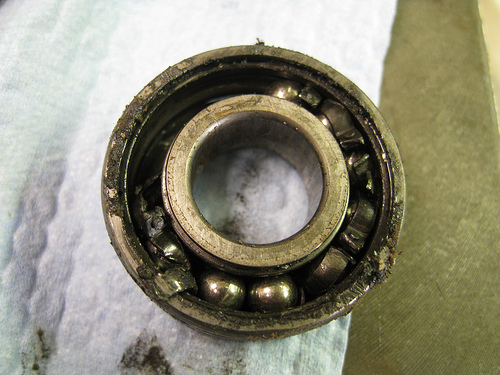One of the single most frustrating and costly problems that befall companies is the unexpected failure of machinery. From pumps to conveyors, or any other type of machine used, there is never a shortage of maintenance required to keep things running smoothly. The only way to combat these seemingly random issues is with a robust and effective Predictive Maintenance (PdM) system. The ability to prevent unexpected losses of time, as well as pricey emergency repairs, is absolutely crucial for a business to remain healthy. Today we’ll discuss one part of PdM.

The equipment this came from was not part of a vibration monitoring program.
An important part of any effective PdM system is Condition Monitoring (CM). CM is the process by which you check the integrity of a piece of equipment by monitoring certain parameters. Vibration Monitoring (VM) is a subset of Condition Monitoring (CM) that focuses on monitoring vibration trends in machinery to help predict and identify developing or worsening faults.
By simply using a device to monitor the vibration of a machine, you are able to closely examine the vibrational signal, as well as compare it to a known background level vibration to help track machine condition. Much can be determined about the condition of a machine through careful parsing of this raw data. For instance, focusing on certain frequencies can yield information about specific machine components, and may even be able to predict component failure weeks or months before it occurs.
To fully understand the importance of VM, it is necessary to examine the potential problems caused by an excessive or abnormal vibration condition:
- Reduction of equipment life span: Improper wear on a machine will cause parts to wear out far more quickly than they are designed to. This will raise costs, due to the need for extra parts and labor, and also hurt productivity by preventing equipment from running when it is needed.
- Structural fatigue of support components: Most equipment (especially heavy rotating equipment) is mounted to a fixture such as a mounting plate or bracket. Abnormal vibration will cause these mounting points to fail far more quickly than expected, resulting in dangerous and costly accidents.
And worst of all,
- Premature equipment failure: Worn bearings, bowed rotors, broken shafts and fan blades – equipment that is vibrating excessively will be much more susceptible to failure before the end of its design life span.
So what can be done about all this? The answer lies in an effective VM program carried out by knowledgeable personnel.
VM can be fairly complex. There are a lot of different things to take into consideration when attempting to interpret the data you receive, and without some sort of help or guidance, it can be difficult to create a truly helpful program. Luckily, there are many devices to help make it an easier process. Vibration monitors can be either portable or fixed, and come in many different configurations. Let’s examine a typical portable vibration monitor.

Figure 1: CSI 2130 Machine Health Analyzer
This is a handheld device used for vibration monitoring. With some attachments, it can also be used to perform several other functions including laser alignment and machine balancing. This particular analyzer has multiple modes to collect data. Let’s look at a couple of those modes.
“Route” mode is commonly used for a scheduled analysis on a group of equipment, such as for PM. The “route” is a preprogrammed set of measurements to be taken. This is extremely useful in that it minimizes the amount of training required to perform basic VM tasks. Simply pull up the route containing the equipment you wish to measure, and perform the measurements in order. When the “Equip List” button is pressed, the analyzer conveniently displays the equipment you are measuring in the upper half of the display, and displays the specific point to be measured on the bottom half.
In “Manual Analyze” mode, the user selects the analyze mode, as well as the measurement and display parameters. This allows for a very high degree of customization. This mode is useful to help with an installation or repair. By allowing you to customize your measurement criteria, it allows you the flexibility needed to perform a one-off job.
The decision to incorporate VM into a regular PM program is one that each facility will make on a case by case basis. Just keep in mind while weighing the decision, how much more will it cost to replace or repair that piece of equipment once it’s already damaged? How much money will be lost if an unexpected stop in work occurs due to a machine failing?
It’s easy to look at this in terms of money/time spent to acquire the right equipment and properly train personnel in its use(s). The real question, though, is how can you afford not to maintain your equipment?


